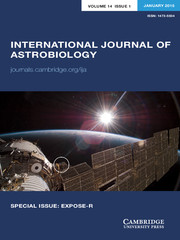Crossref Citations
This article has been cited by the following publications. This list is generated based on data provided by Crossref.
Forgan, Duncan H.
2011.
Spatio-temporal constraints on the zoo hypothesis, and the breakdown of total hegemony.
International Journal of Astrobiology,
Vol. 10,
Issue. 4,
p.
341.
Glade, Nicolas
Ballet, Pascal
and
Bastien, Olivier
2012.
A stochastic process approach of the drake equation parameters.
International Journal of Astrobiology,
Vol. 11,
Issue. 2,
p.
103.
Hair, Thomas W.
2013.
Provocative radio transients and base rate bias: A Bayesian argument for conservatism.
Acta Astronautica,
Vol. 91,
Issue. ,
p.
194.
Hair, Thomas W.
and
Hedman, Andrew D.
2013.
Spatial dispersion of interstellar civilizations: a probabilistic site percolation model in three dimensions.
International Journal of Astrobiology,
Vol. 12,
Issue. 1,
p.
45.
Morrison, Ian S.
and
Gowanlock, Michael G.
2015.
Extending Galactic Habitable Zone Modeling to Include the Emergence of Intelligent Life.
Astrobiology,
Vol. 15,
Issue. 8,
p.
683.
Stevens, Adam
Forgan, Duncan
and
James, Jack O'Malley
2016.
Observational signatures of self-destructive civilizations.
International Journal of Astrobiology,
Vol. 15,
Issue. 4,
p.
333.
de Magalhães, João Pedro
2016.
A direct communication proposal to test the Zoo Hypothesis.
Space Policy,
Vol. 38,
Issue. ,
p.
22.
Grimaldi, Claudio
2017.
Signal coverage approach to the detection probability of hypothetical extraterrestrial emitters in the Milky Way.
Scientific Reports,
Vol. 7,
Issue. 1,
Forgan, Duncan H.
2017.
The Galactic Club or Galactic Cliques? Exploring the limits of interstellar hegemony and the Zoo Hypothesis.
International Journal of Astrobiology,
Vol. 16,
Issue. 4,
p.
349.
Cai, Xiang
Jiang, Jonathan H.
Fahy, Kristen A.
and
Yung, Yuk L.
2021.
A Statistical Estimation of the Occurrence of Extraterrestrial Intelligence in the Milky Way Galaxy.
Galaxies,
Vol. 9,
Issue. 1,
p.
5.
Smith, Reginald D.
2023.
Communicating extraterrestrial intelligence (CETI) interaction models based on the Drake equation.
International Journal of Astrobiology,
Vol. 22,
Issue. 2,
p.
157.
Lacki, Brian C.
2024.
Artificial Broadcasts as Galactic Populations. I. A Point Process Formalism for Extraterrestrial Intelligences and Their Broadcasts.
The Astrophysical Journal,
Vol. 966,
Issue. 2,
p.
182.

